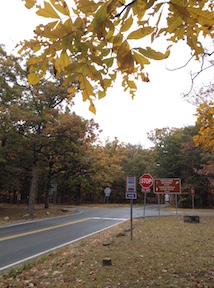Writing the Wilderness and Reflecting

It’s 46° in Spotsylvania County, but the morning clouds have marched away and the blue-sky sun makes it feel more like sixty. To the west, another line of gray clouds hangs over the Blue Ridge Mountains like a haze of forest fire smoke.
I’m passing through the Wilderness. By habit, I refer to it as “the dark, close wood,” a phrase I used for the title one of my first books. It comes from J. F. J. Caldwell of the 1st South Carolina and his History of a Brigade of South Carolinians: “Danger is far less formidable in the bright, open, ventilated field, than in the dark, close wood. . . .” Now, any time I write about the battle, I try to work in the phrase as my own little inside joke.
Today, though, the Wilderness looks neither dark nor close. The skeleton trees let in a lot of naked sunlight—but that hardly makes it “bright, open, ventilated,” either. If anything, it’s a little bleak in its brown starkness.
Kris White and I are finishing up an article about the battle of the Wilderness for Blue & Gray magazine. Whenever I write about the battle, I feel drawn specifically to the Brock Road/Plank Road intersection. It was, for three days in early May 1864, the most important intersection in America—and in my opinion, the turning point of the war.
As is the case for any of us who love battlefields, different landscapes hold different meanings to us. We all have our favorite battlefields, and at any specific battlefield, we all have our favorite places.
Here in the Wilderness, I’ve spent most of my time in Saunders Field, giving tours for National Park Service visitors. I also feel a connection to Elwood because it’s the resting place of Stonewall Jackson’s arm (and because it’s a great old house). My favorite story from the battle is the wounding of James Longstreet, which had far-reaching implications for the Army of Northern Virginia—more so than even the wounding of Stonewall Jackson a year and three days earlier three miles from the spot of Longstreet’s wounding. It’s an underappreciated story.
But of all the places in the Wilderness that I feel connected to, the Brock Road/Plank Road intersection pulls at me strongest.
There’s nothing particularly beautiful about the spot today. Several large gated communities tucked away in the surrounding forests mean thousands of cars pass through the busy intersection every day. Often, litter clutters the sides of the road. There are a couple small monuments and some Park Service signs, and the remains of three lines of earthworks faintly parallel the Brock Road, which winds and rolls ten miles down to Spotsylvania Court House.
In the northeast quadrant of the Brock Road/Plank Road intersection, the Civil War Trust recently purchased 355 of acres to create a land bridge connecting the Wilderness to Chancellorsville. Interpretively, there is a little connection between the two beyond geography, but the purchase represents a huge block of unspoiled land that helps preserve the overall integrity of the battlefields. Considering the number of people already living in housing developments in the area, and the ever-present threat of more development, the importance of this preservation effort cannot be overstated.
The northwest quadrant borders on one of the large subdivisions in the area. The southeast quadrant offers more undeveloped forest but it, too, bumps up against houses.
In the southwest quadrant of the intersection, a beautiful walking trail unspools through the woods and passes the impressive Vermont monument; in the summer and fall, it’s an especially pretty walk. In the distance, beyond the haunting trees and the landscape pitted with depressions left by temporary graves, a massive gated community lurks.
The modern landscape hardly does justice to the ferocity of the fighting in this area back in 1864. I think particularly of the Confederates breaking through a line of burning log works on the afternoon of May 6 and engaging in hand-to-hand combat. Federal reinforcements flooded in among the flames to plug the gap.
I think, too, of the evening of May 7, when Ulysses S Grant came to this same crossroads. He could have turned back, as all other Federal commanders had done before him, but instead, he moved on, keeping his word. “There will be no turning back,” he’d vowed, and sticking to that promise begin the long process of attrition that defeated the confederacy. James Longstreet had predicted, “That man will fight us every day and every hour till the end of the war,” and Grant proved him right.
I’m privileged to live so close that I can return to such spots as this and reflect on what happened here. The landscape still bears hints of the stories that unfolded here, although I wonder how many of those thousands of drivers that daily pass through take the time to look, to see. For that matter, how often do I drive by places like this without really seeing?
I’m glad to be working on the story of this battle, yet again. There remains so much to tell. There remains so much yet to see.
Nice piece, Chris.
Thanks, Ted. After writing Hell Itself: The Battle of the Wilderness (Savas Beatie, 2016), I wondered how to approach the battle again so soon. Fortunately: Mr. White to the rescue!
(There’s a book plug for my publisher, Mr. Savas–how’s that?) 😉